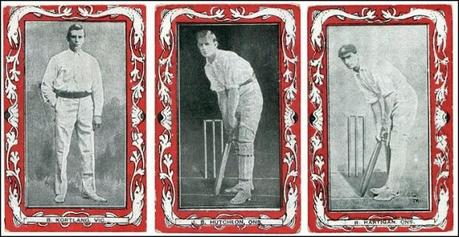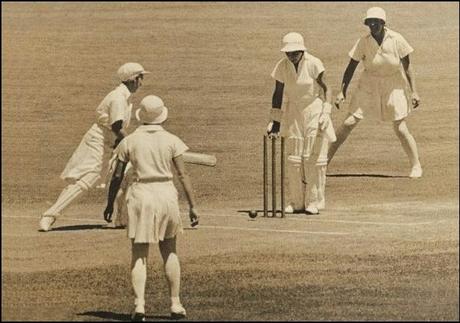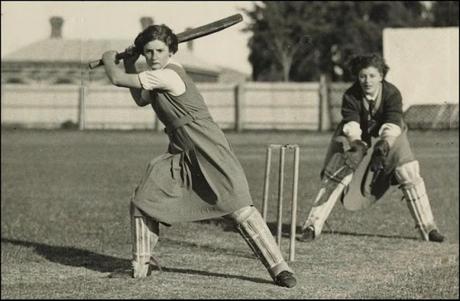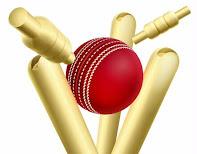More specifically, I thought I'd trace the history of cigarette cards - and we'll get to the cricketing connection shortly. Cards in packs of cigarettes became commonplace in America in the 1880s when pieces of blank card known as stiffeners were inserted into predominantly paper packs (which differed from the cardboard packs we are used to in the UK), to make them more robust.
It wasn't long before someone hit on the bright idea of printing advertisements on the stiffeners, and the next logical step was to print the cards with something that people might consider collectable, as a means of giving a brand an edge over the competition and selling more cigarettes. I can attest to the power of such marketing because as a child I used to badger my parents to buy specific brands (not of cigarettes, for neither of them smoked) but of Ty-Phoo tea and Chivers jelly, so I could collect their different series of picture cards. By the way, the collecting of cards is known as cartophily.
W.D. & H.O. Wills of Bristol was the first British cigarette manufacturer to include picture cards in their packets in 1888. Their first set of coloured cards was themed 'Ships and Soldiers', presumably to appeal to their target demographic. Other series soon followed, usually comprising 25 to 50 different images, with text on the reverse. 'Kings & Queens' was a particularly popular and even educational series. By 1900, other companies like John Player & Sons and Ogdens were running with collectable cigarette cards in their merchandise. Topics proliferated from all three companies: weapons, dogs, racehorses, boxers, wild flowers, cars, footballers and yes, cricketers.

W.D. & H. O. Wills cigarette cards - Cricketers i
The two sets of images I've chosen here (above and below) were actually sold in packs of cigarettes manufactured and sold by the Australian arm of W.D. & H. O. Wills in 1910. Unsurprisingly the 50 card set featured Australian (red border) and South African (blue border) cricketers of the pre-World War era, with not a Pom in sight. They were also known as trading cards, because anyone with duplicates (and you never knew who you'd find in your packet of 20) could engage in swapping with their mates for cards they didn't already have.The English series of Will's Cricketers (one in 1908 and another in 1929) fetch modest prices in the low hundreds of pounds for a full set in good condition. The much rarer Australian series illustrated here can sell for over a thousand pounds - which by a curious symmetry is approximately the modern-day cost of 50 packets of cigarettes (or so I am told).

W.D. & H. O. Wills cigarette cards - Cricketers ii
Of course a century ago, all the picture card images were of male cricketers, for cricket was a man's game... wasn't it? Well no, not exactly.The first recorded instance of a women's cricket match dates from 1745, when the Reading Mercury reported on a game between "eleven maids of Bramley and eleven maids of Hambledon", the latter running out winners by 127 runs to 119. Women's cricket was far more widespread than women's football in the 18th and 19th centuries. There were many local ladies' teams up and down the country, just not the same level of competition or representation at county or country level. In the 1890s a team known as the Original English Lady Cricketers toured the country playing exhibition matches and it was only a few decades later that the Women's Cricket Association was formed and an England team was playing test matches against Australia.

women's cricket test match, Australia v England 1935
I suppose it was thought that cricket, being essentially a non-contact sport, was an acceptable game for women to play, whereas football and rugby were not. It took the best part of another century for the general consensus regarding the latter two (along with boxing and wrestling) to change sufficiently to make them mainstream sports for women, and even then there are cultural undertows of resistance to the idea.But cricket forged ahead. It was on the sports curriculum, along with hockey and lacrosse, at many girls' schools in the 20th century. One of my housemates when I first lived and worked in London had played cricket at her secondary school and then for her college.
In the 21st century the language of the game has finally caught up. The ones who wield the bat are now universally referred to as batters. It was always batsmen and batswomen in my youth. I often wondered why not batmen and batwomen, but I suppose that was to avoid any confusion with military orderlies or caped crusaders. Of course it was always bowlers and never bowlsmen or bowlswomen. Thankfully we still have all the quaint fielding terminology of slips, gulleys, silly mid-off, cover, square leg, short fine leg, mid-wicket, backward point, long on, long off, deep third and so on, and maiden overs of course.
And just in case you should imagine that girly cricketers are demure and genteel maids, I leave you one final, riveting image. That could almost be a broadsword she's brandishing!

a striking pose
To conclude, this latest poem is a shameless bit of fun...just not cricket, eh chaps? It's subject to refinement, and may be the last narrative-style poem I write for a while as I seek a new directionMaiden OverShe was really hoping for a leg over at long stopor at least a fondle and a fag behind the screens.Conventions were being set aside for once
on the banks of the Moray, with the likely lads of St. Ignatius College first team playing hostto the sporting damsels of nearby Lossiemouth,
one innings each on a perfect summer's dayon the verdant oval of the Elgin Cricket Club,no fear for once of rain or bad light halting play.
He saw it as a chance to shine, impress a lass andif his luck was in sneak her off behind the pavilionduring tea for a spot of mutual fielding practice.
Except that fate, ever the contrary spoiling bastardthwarted his plans of showing a captain's flair,leading from the front and sweeping her for six
as he failed to connect with the first two deliveriesof this maiden's over, then diverted her deceptivepacey third on to his own wicket. Out for a duck.
It was a long, frustrating wait for him as he watchedhis team mates battle with the Lossie lasses. He triednot to catch her eye at lunch while others vied to chat
and it was a relief when St. I's were all out for 209and it was the ladies' turn to bat. As he faced herto bowl, did she smile or was that a smirk? The sun
was in his eyes. He took a run up and flung it down.A gasp - "no ball" called the umpire. Same thing againand a curt word in his ear: "Remember who you're
playing against young sir", as if he could forget. Hisslower balls she stroked for two, for two, then four.After that he chose not to bowl anymore, deploying
the other bowlers in the side. They did a decent joband Lossiemouth were eventually out for 182, thoughshe was undefeated on 75, a hollow victory for him
and 'player of the match' for her. As she remarked to the St. I's coach who was genially chatting her up at the pavilion bar "It seems to me it's your captain
who's in need of a stiffener" and he agreed as he tookher arm and guided her out of the throng and into thepleasant gloam of evening to where the grass grew long.

Thanks for reading. Comments/feedback appreciated, S ;-) Email ThisBlogThis!Share to TwitterShare to Facebook
